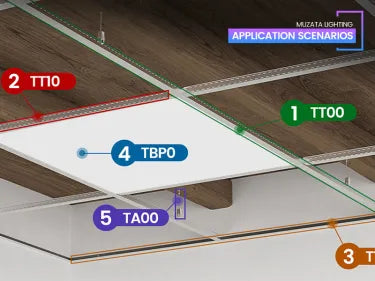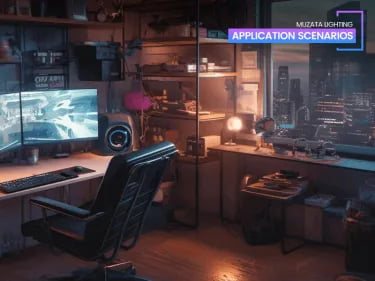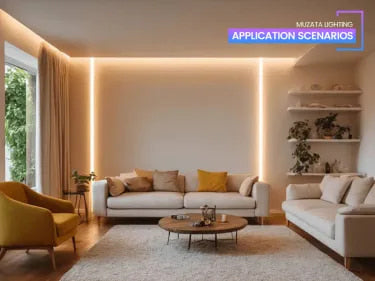TABLE OF CONTENTS
Illuminate and Elevate: Feeling Your LED Stair Lights Magic
Imagine walking up your staircase at night, each step illuminated by a soft, ambient glow that not only lights your way but also adds a touch of elegance to your home. Staircases often go unnoticed when it comes to home decor, yet they hold the potential to be one of the most striking features in your living space. Enter LED stair lights: a modern, efficient, and stylish solution to transform your stairs into a captivating focal point.
---
In this article, we'll delve into why LED Stair Lights are the ultimate choice for stair lighting, how to seamlessly install and hide them, determine the optimal lumens needed, and explore various creative placement ideas. Get ready to brighten your home and elevate your staircase to new heights of sophistication and safety!

✧ Why Choose LED Stair Lights for Stair Lighting?
LED Stair Lights offer several advantages that make them perfect for stair lighting:
- Energy Efficiency: LEDs use significantly less energy compared to traditional incandescent bulbs, leading to lower electricity bills and a reduced carbon footprint.
- Longevity: LED Stair Lights have a longer lifespan, often lasting up to 50,000 hours, which means fewer replacements and maintenance hassles.
- Flexibility: LED Stair Lights are flexible and can be cut to fit any length, making them ideal for staircases of all shapes and sizes.
- Variety of Colors and Brightness Levels: With LEDs, you can choose from a wide range of colors and adjust brightness levels to create the perfect ambiance.
- Safety: Proper stair lighting reduces the risk of accidents by clearly illuminating each step, which is especially important in homes with children and elderly individuals.
✧ How to Install LED Stair Lights on Stairs
Installing LED lights on your stairs can be an exciting and rewarding DIY project. Here’s a detailed, step-by-step guide to help you through the process:
1️⃣ Plan Your Layout
Begin by carefully planning where you want the lights to go. Measure the length of each stair tread to determine how much LED strip stair lighting you'll need. Decide whether you want the lights under the lip of each step, along the handrail, or perhaps recessed into the wall. Mark the positions with a pencil or painter's tape. Planning is crucial as it helps you visualize the final look and ensures you purchase the correct amount of materials.
2️⃣ Cut the LED Strips
Once you’ve planned your layout, it's time to cut the LED strips to the desired lengths. LED strips are designed to be cut at specific intervals (usually marked by small scissors icons on the strip). Use sharp scissors or a utility knife to make clean cuts at these points to avoid damaging the circuit. Measure twice, and cut once to ensure precision.
3️⃣ Attach the Strips
Peel off the adhesive backing from the LED strips and carefully stick them in place according to your layout plan. Start at one end and gradually press down the strip to ensure it adheres smoothly without air bubbles. For added security, especially in high-traffic areas, you might want to use additional adhesive or mounting clips. These will help keep the strips in place over time.
4️⃣ Connect the Strips
After attaching the strips, connect them to the power source using the appropriate connectors. Make sure all connections are secure to avoid electrical issues. Soldering the connections can provide a more permanent and reliable bond, but many LED kits come with plug-and-play connectors that are easy to use. Ensure that the power source is appropriately rated for the total length of the LED strips to prevent overheating.
5️⃣ Install a Dimmer or Controller
For added convenience and customization, consider installing a dimmer switch or a smart controller. This allows you to adjust the brightness and even change the color of the lights, depending on the type of LEDs you have. Smart controllers can be connected to home automation systems, enabling you to control your stair lighting via smartphone or voice commands.
✧ How Many Lumens Do I Need for Stair Lights?
The brightness of your LED Stair Lights is crucial for both safety and aesthetics. Here's a guideline to determine the lumens needed:
- Ambient Stair Lighting: For general illumination, aim for 12-20 lumens per square foot.
- Task Stair Lighting: If the lights are intended to highlight the steps and enhance safety, 100-200 lumens per step are recommended.
- Accent Stair Lighting: For purely decorative purposes, 35-50 lumens per square foot will suffice.
✧ Where to Place Stair Lights?
Proper placement of stair lights is key to achieving the desired effect. Here are some placement ideas to consider:

Under the Lip of Each Step
Placing LED strips under the lip of each step provides direct illumination on each tread. This method enhances visibility and safety, creating a floating effect that makes the stairs look modern and elegant. This placement is particularly useful in darker areas where safety is a concern. The light is directed downward, reducing glare and making each step clearly visible.
Recessed LED Stair Lights Near the Steps
Installing recessed LED Stair Lights in the wall adjacent to the staircase creates a sleek, modern look while effectively Stair lighting up the steps. These LED Stair Lights can be positioned at regular intervals along the staircase, providing even illumination. Recessed LED Stair Lights are also less likely to be damaged as they are embedded into the wall, making them a durable option.

Handrail LED Stair Lighting
Integrating LED strips into the handrail offers both functional and aesthetic benefits. It ensures the handrail is always visible, which is particularly useful in low-light conditions. This placement provides indirect lighting that is easy on the eyes and adds a unique design element to your staircase. Handrail LED stair lighting can be continuous or segmented, depending on the design of the handrail and your personal preference.

LED Backlighting
Placing LED strips behind each step or under a glass or acrylic step creates a dramatic and contemporary floating effect. This method highlights the structure of the staircase and can be particularly striking in modern homes. The backlighting provides a soft, diffused glow that enhances the architectural features of your staircase. This type of lighting works well in combination with other lighting methods for a layered lighting design.
✧ Do You Need to Protect Your LED Stair Lights?
Protecting your LED Stair Lights is essential for ensuring they last longer and continue to perform optimally. Here are some detailed protection tips:
LED channels
LED channels can protect the LEDs from dust and physical impact while also improving light diffusion. They spread the light more evenly, reducing harsh shadows and glare. LED channels are available in various materials and shapes, allowing you to choose one that best fits your aesthetic and functional needs. Installing a diffuser over the LED strip can also enhance the overall look by giving a more polished and professional finish.

" The LED channels really make my LED tape strips look very professional. It gives a clean finished look and the diffuser effect is pleasing to the eye "--Reviews from users
Waterproof Strips
If your staircase is outdoors or in a high-humidity area such as a basement or near a pool, using waterproof LED strips is crucial. These strips are coated with a protective layer that shields the LEDs from moisture and potential water damage. Waterproof strips are typically rated with an IP (Ingress Protection) rating, indicating their resistance to water and dust. Choose a strip with a suitable IP rating for your environment.
Proper Installation
Ensuring the LED strips are securely installed is important to avoid damage from foot traffic or accidental bumps. Use additional mounting hardware if necessary, and make sure the adhesive is strong enough to hold the strips in place over time. Avoid placing strips in areas where they might be easily kicked or knocked loose. Secure any loose wires and connections to prevent tripping hazards and ensure a clean installation.
Voltage Regulation
Use appropriate voltage drivers and transformers to prevent electrical surges that could damage the LEDs. LED strips typically operate at low voltage, so it's important to use the correct power supply. Overloading the LEDs with too much voltage can shorten their lifespan and cause them to fail prematurely. Additionally, consider installing surge protectors to safeguard against power spikes that could damage your LED stair lighting system.
✧ Conclusion
LED stair lights are a versatile and stylish way to enhance the safety and aesthetics of your staircase. With the right planning and installation, you can create a stunning visual effect that transforms your stairs into a focal point of your home. Whether you opt for under-step lighting, recessed wall lights, or handrail lighting, the possibilities are endless. So why wait? Illuminate your staircase with LED strip lights and experience the perfect blend of form and function.
By integrating the latest LED stair lights into your home, you're not just upgrading your stair lighting—you're investing in style, safety, and innovation. Enjoy the enhanced ambiance and safety that come with professionally installed stair lighting, and let your staircase shine as a true testament to modern design and practical elegance.
Related Reading ▶️
Best Stair Step Lights for Home: Hands-free & Sensor-activated
ABOUT THE AUTHOR





